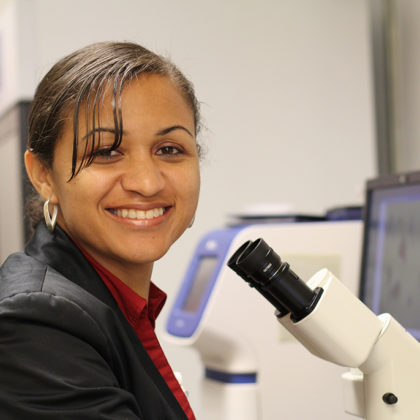Next-generation stem cell scientists evidence strong nerves at USC mini-symposium
Five next-generation scientists got everyone’s neurons firing at the Junior Faculty Candidate Mini-symposium, hosted by USC’s Department of Stem Cell Biology and Regenerative Medicine on March 7.
World Kidney Day: USC’s Andy McMahon and Ken Hallows discuss kidney health and research
One in 10 people is affected by chronic kidney disease worldwide. On March 9, 2017, World Kidney Day shines a spotlight on the importance of kidneys and ways to reduce the impact …
Support the UKRO Los Angeles Marathon Charity Relay Team
One out of every two adults will develop chronic kidney disease during their lifetimes. To help these patients, USC scientists and clinicians are putting their feet to the task as part of …
Broad Innovation Award winners aim to reduce bathroom breaks with stem cells
Having a baby can change a woman’s life in one way that she is often too embarrassed to mention. Childbirth can cause urinary incontinence, which affects up to 13 million people and …
What I’m Reading: Top pick from stem cell faculty member Senta Georgia
Earlier this year, a team at the Karolinska Institute published a paper that profiled gene activity in single cells from human embryos created in the context of in vitro fertilization. Now this …
What I’m Reading: Top pick from stem cell faculty member Qi-Long Ying
In a recent study published in Cell Stem Cell, Joshua Black and colleagues demonstrated that skin cells are converted into neurons using a powerful tool called CRISPR/Cas9 to concurrently modify and activate …
What I’m reading: Top pick from stem cell faculty member Wange Lu
Our genetic material is packed into the nucleus of the cell, but is the packing process random or organized in some way? In a recent study published in Cell Stem Cell, Krijger …
What I’m reading: A top pick from stem cell faculty member Joseph T. Rodgers
In a recent issue of Science, Jay Shendure, Alexander Schier and colleagues present an extraordinarily powerful new approach to trace the lineage of cells as they divide within an organism.
What I’m reading: Top picks from stem cell faculty members Andy McMahon and Gage Crump
Andy McMahon: Leigh Turner and Paul Knoepfler present a disturbing report in Cell Stem Cell on the growth of businesses marketing stem cell interventions in the US. Los Angeles is one “stem …
A gene called Prkci helps organize organisms and their organs
A gene called Prkci can point cells in the right direction, according to a new study in Developmental Biology. In the study, USC Stem Cell researcher In Kyoung Mah from the laboratory …
Amplifying cell signals for potentially lower cost stem cell interventions
Editor’s Note: USC Stem Cell principal investigators Malcolm Snead and Yan Zhou were among the authors of “Supramolecular Nanofibers Enhance Growth Factor Signaling by Increasing Lipid Raft Mobility,” published on April 12, …
USC Stem Cell scientists enter the conversation about CRISPR
CRISPR-Cas9 is a gene-editing technique that enables scientists to disable, replace or modify sections of DNA. It allows for unprecedented precision and speed in the field of genome editing. It has been used to …
Four honored at UKRO benefit gala
University Kidney Research Organization (UKRO) honored USC academic and scientific leaders at its sixth gala dinner March 18 at The Beverly Hilton, with 300 attendees. This group of vocal champions of kidney …
USC researchers discover a key difference between mouse and human kidney stem cells
The best laid plans of mice and men are a bit different — at least when it comes to kidney development. Compared to a mouse, a human has nearly 100 times more nephrons, …
USC Stem Cell mini-symposium introduces next-generation researchers
The next generation of scientists is turning to stem cells to advance our understanding of systems ranging from the blood to the brain, from the liver to the lungs. Six of these …
Scientists Qi-Long Ying and Austin Smith win the 2016 McEwen Award for Innovation
Video by Henry Liu Researchers Qi-Long Ying from USC and Austin Smith from the University of Cambridge have won the 2016 McEwen Award for Innovation, the highest honor bestowed by the International …
UKRO benefit dinner to honor USC leaders
University Kidney Research Organization (UKRO) will honor a stellar group of USC academic and scientific leaders at its sixth gala dinner on March 18 at The Beverly Hilton. This group of vocal …
A Prkci gene keeps stem cells in check
When it comes to stem cells, too much of a good thing isn’t wonderful: producing too many new stem cells may lead to cancer; producing too few inhibits the repair and maintenance …
Postdoctoral fellow Albert Kim receives first Hearst Fellowship
How do you turn stem cells into nephrons, the functional unit of the kidney? Albert D. Kim, a postdoctoral fellow in the laboratory of Andy McMahon, is exploring this question with support …
Chang Stem Cell Engineering Facility brings gene editing to USC and beyond
Once the stuff of science fiction, genetic engineering is now offered on a fee-for-service basis at USC. On September 19, USC Stem Cell faculty and staff welcomed their supporters, the Chang and …


















